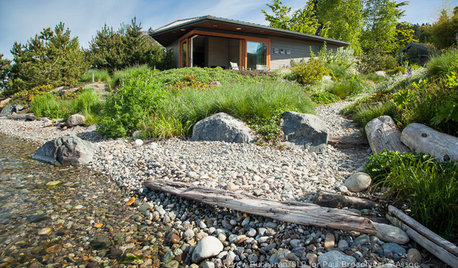New Old Lawn
mwwhite
11 years ago
Related Stories

GARDENING GUIDESHow to Prep Your Ground for a Healthy New Lawn
Seed or sod that falls on weedy, lumpy soil is a wasted effort. Follow these steps to ensure that your new lawn will thrive
Full Story
GRASSESHow to Rock a Lawn
Weekend Project: The key to healthy grass begins with the soil. If turf works for you, here’s how to fix it and keep it looking its best
Full Story
INSPIRING GARDENSLawn Gives Way to a More Natural Lakeside Garden
Meadow grasses, beach pebbles and driftwood replace turfgrass in a nature-friendly landscape on Lake Washington’s shore
Full Story
BEFORE AND AFTERSSee 6 Yards Transformed by Losing Their Lawns
Wondering whether a turf lawn is the best use of your outdoor space? These homeowners did, and they found creative alternatives
Full Story
FRONT YARD IDEASBefore and After: Front Lawn to Prairie Garden
How they did it: Homeowners create a plan, stick to it and keep the neighbors (and wildlife) in mind
Full Story
LANDSCAPE DESIGNGet Along With Less Lawn — Ideas to Save Water and Effort
Ditch the mower and lower your water bill while creating a feast for the eyes with diverse plantings and gathering places
Full Story
GREAT HOME PROJECTSHow to Replace Your Lawn With a Garden
New project for a new year: Lose the turfgrass for energy savings, wildlife friendliness and lower maintenance
Full Story
EARTH DAYThe Case for Losing the Traditional Lawn
Work less, help the environment and foster connections by just saying no to typical turf
Full Story
LAWN ALTERNATIVESStop Fighting the Patchy Lawn!
Here are 3 situations where a garden may be a better idea than more turfgrass
Full Story
LANDSCAPE DESIGNCalifornia Says Goodbye to the Sprawling Ornamental Lawn
New state rules will effectively limit turfgrass to 25 percent of the landscape in most new and renovated yards
Full StorySponsored
Industry Leading Interior Designers & Decorators in Franklin County
More Discussions






dchall_san_antonio
Related Professionals
Holly Springs Landscape Architects & Landscape Designers · Benbrook Landscape Architects & Landscape Designers · Grand Haven Landscape Architects & Landscape Designers · Salisbury Landscape Architects & Landscape Designers · Woburn Landscape Contractors · Arden-Arcade Landscape Contractors · Essex Landscape Contractors · Fort Atkinson Landscape Contractors · Glendale Heights Landscape Contractors · McLean Landscape Contractors · Pleasant Grove Landscape Contractors · Streamwood Landscape Contractors · West Palm Beach Landscape Contractors · Westford Landscape Contractors · Drexel Hill Swimming Pool Builders